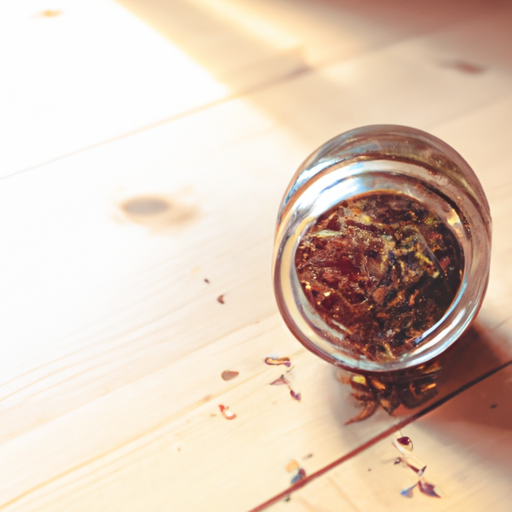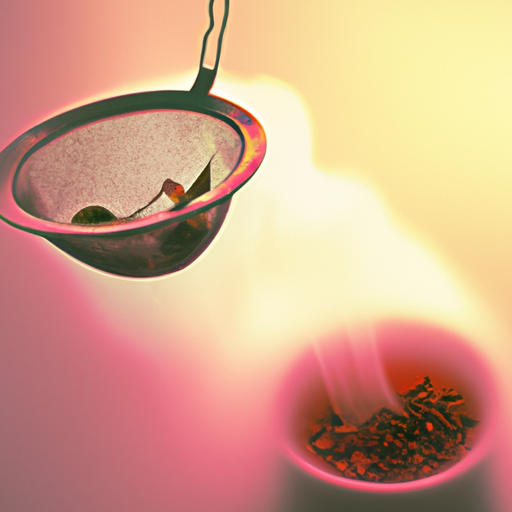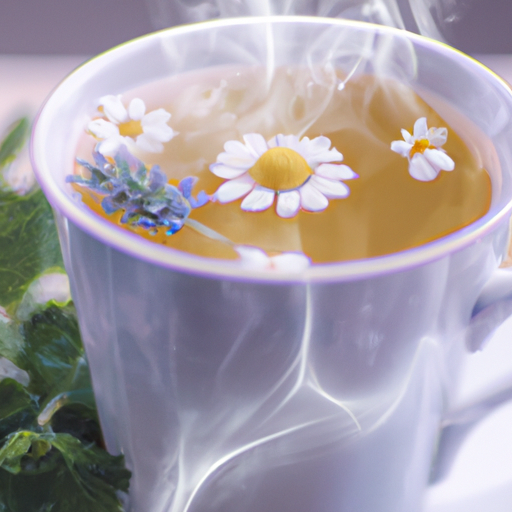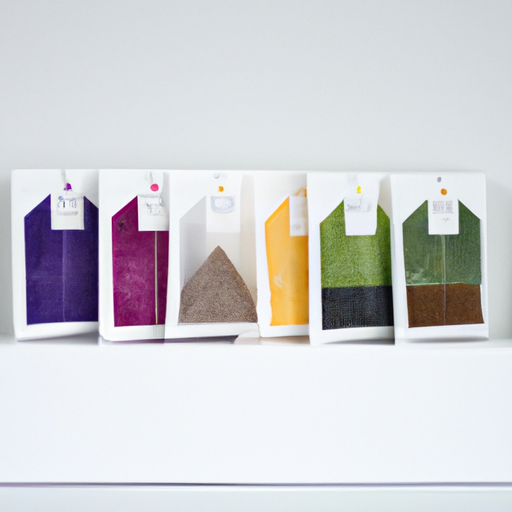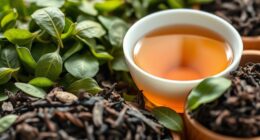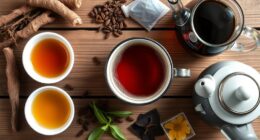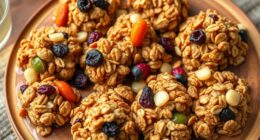Have you ever opened a jar of loose herbal tea, only to find that it has lost its vibrant aroma and flavor? Just like a delicate flower wilts over time, loose herbal tea also has a shelf life. It’s important to know how long your tea will remain fresh and flavorful, so you can fully enjoy its benefits.
In this article, I will explore the shelf life of loose herbal tea in a jar and provide tips on how to determine its freshness. I will also share effective strategies to extend the shelf life of your tea and common mistakes to avoid. Additionally, I’ll delve into the benefits of consuming fresh loose herbal tea and even offer creative suggestions for using expired tea.
By the end, you’ll have a comprehensive understanding of the lifespan of your beloved loose herbal tea and how to make the most of it.
Key Takeaways
- The shelf life of loose herbal tea in a jar can vary from 6 months to a year if stored properly.
- The freshness of loose herbal tea can be determined by evaluating color, texture, and signs of mold or spoilage.
- Proper storage of loose herbal tea includes using an airtight container, keeping it in a cool, dark place, and avoiding exposure to sunlight, heat, and strong odors.
- Expired loose herbal tea can be repurposed for DIY beauty products, used as a natural cleaning solution, or composted for plant growth.
Understanding Shelf Life of Loose Herbal Tea
Do you know how long your loose herbal tea in a jar stays fresh? Understanding the shelf life of loose herbal tea is important for determining expiration and preserving its quality.
The freshness of loose herbal tea can vary depending on several factors such as the type of tea, storage conditions, and processing methods. Generally, loose herbal tea can stay fresh for about 6 months to a year if stored properly in an airtight container away from light, heat, and moisture. However, it’s important to note that the flavor and aroma of the tea may diminish over time.
In the subsequent section, we’ll explore ways to determine the freshness of loose herbal tea without compromising its quality.
Determining Freshness of Loose Herbal Tea
When it comes to determining the freshness of loose herbal tea, there are a few key points to consider. First, using your senses is crucial in evaluating the tea’s quality. Conducting a visual inspection allows you to assess the color, texture, and any signs of mold or spoilage.
Finally, performing a taste test can help you identify any off-flavors or stale notes that may indicate the tea is past its prime.
Using Your Senses
As I open the jar of loose herbal tea, the fragrant aroma fills the air, enticing my senses. The scent is a crucial factor in determining the freshness of the tea. By using my sense of smell, I can detect any signs of staleness or off-notes.
Next, I explore the texture of the tea leaves. I gently rub a few leaves between my fingers to feel their consistency. Fresh tea leaves should feel pliable and springy, not brittle or crumbly. Additionally, I pay attention to any signs of moisture or clumping, as these may indicate the presence of mold or moisture damage.
Lastly, I take note of the color of the leaves, which should be vibrant and uniform. Conducting a visual inspection allows me to gather more information about the quality and freshness of the loose herbal tea.
Conducting a Visual Inspection
With a quick visual inspection, you can immediately assess the quality and freshness of the aromatic loose herbal tea. Visual inspection techniques are essential in determining signs of spoilage. By examining the tea leaves, you can look for any discoloration, mold growth, or presence of insects. A simple yet effective way to conduct a visual inspection is to place a small amount of tea leaves on a white background and observe any abnormalities. Here is an example of what you might see:
| Normal Tea Leaves | Spoiled Tea Leaves |
|---|---|
| Vibrant green color | Discolored or brownish |
| Intact and whole leaves | Broken or crumbled |
| Fresh and crisp appearance | Dull or withered texture |
| No signs of mold or insects | Mold growth or presence of insects |
By carefully examining the tea leaves, you can determine whether they are still suitable for consumption. Performing a taste test will further confirm their quality and flavor.
Performing a Taste Test
To truly experience the essence of the aromatic loose herbal tea, take a sip and let its flavors dance on your palate. Performing a blind taste test can help you appreciate the nuances and subtleties of different tea varieties. Compare the loose herbal tea to bagged tea to see if there are noticeable differences in flavor, aroma, and overall quality.
In a blind taste test, you won’t know which tea is which until after you’ve made your evaluation. This eliminates any bias and allows you to make a fair comparison between the two. It’s important to note that loose herbal tea often offers a more robust and complex flavor profile compared to bagged tea. With its superior freshness and higher quality ingredients, loose herbal tea provides a truly indulgent tea-drinking experience.
Moving forward, let’s explore how to extend the shelf life of loose herbal tea.
Extending the Shelf Life of Loose Herbal Tea
Storing loose herbal tea in a jar can help preserve its freshness and flavor for an extended period. To extend the shelf life of loose herbal tea, there are a few key steps to follow.
First, make sure the jar is airtight, as exposure to air can cause the tea to lose its flavor and potency. Additionally, keep the jar in a cool, dark place, away from sunlight and moisture, as these factors can accelerate the tea’s degradation.
It’s also important to handle the tea with clean, dry hands or utensils to prevent contamination.
By following these guidelines, you can ensure that your loose herbal tea stays fresh and flavorful for a longer period of time. Taking these precautions will help you avoid common mistakes that can lead to the deterioration of your tea’s quality.
Common Mistakes to Avoid
Avoid making these common mistakes when storing your precious loose herbal tea to ensure its flavors remain vibrant and delectable.
One common mistake is storing loose herbal tea in a jar that isn’t airtight. Oxygen and moisture can quickly degrade the quality of the tea, causing it to lose its flavor and aroma. It’s important to invest in a proper airtight container to preserve the freshness of the tea for a longer period.
Another mistake to avoid is exposing the tea to direct sunlight or heat. Both of these factors can accelerate the deterioration of the tea leaves and diminish their flavor.
Lastly, it’s crucial to keep the tea away from strong odors, as tea leaves are highly absorbent and can easily take on the smell of nearby items.
By avoiding these common mistakes, you can ensure the longevity and freshness of your loose herbal tea.
Transitioning to the benefits of fresh loose herbal tea, let’s explore the numerous health advantages it offers.
Benefits of Fresh Loose Herbal Tea
Indulge yourself in the rich and invigorating flavors of fresh loose herbal tea, and experience the myriad of health benefits it brings. Not only does fresh loose herbal tea offer a delightful taste, but it also provides numerous advantages for your well-being.
Here are four reasons why incorporating fresh loose herbal tea into your daily routine can be beneficial:
-
Antioxidant Power: Fresh loose herbal tea is packed with antioxidants that help fight against free radicals and reduce the risk of chronic diseases.
-
Digestive Aid: The natural compounds found in fresh loose herbal tea can promote healthy digestion, alleviate bloating, and soothe an upset stomach.
-
Immune Boost: The vitamins and minerals present in fresh loose herbal tea can strengthen your immune system, making you less susceptible to illnesses.
-
Relaxation and Stress Relief: Certain fresh loose herbal teas, like chamomile and lavender, have calming properties that can soothe your mind and promote relaxation.
By harnessing the power of fresh loose herbal tea, you can enhance your overall well-being and enjoy its many health benefits. Now, let’s explore creative uses for expired loose herbal tea without wasting a single ounce.
Creative Uses for Expired Loose Herbal Tea
When it comes to expired loose herbal tea, there are actually quite a few creative uses that you can explore.
One option is to repurpose it for DIY beauty products such as facial scrubs or hair rinses.
Another option is to use it as a natural cleaning solution for your home, as certain herbs can have antibacterial properties.
Lastly, you can even compost your expired loose herbal tea, as it can add nutrients to your soil and help with plant growth.
DIY Beauty Products
Looking to pamper yourself? Did you know you can make your own beauty products using loose herbal tea in a jar? Loose herbal tea can be a great addition to your DIY skincare routine, offering a variety of benefits for your skin.
Here are three sub-lists to explore the different ways you can incorporate loose herbal tea into your homemade face masks:
-
Antioxidant Boost:
-
Green tea: Rich in antioxidants, it helps fight free radicals and rejuvenate the skin.
-
Chamomile tea: Soothes irritated skin and reduces inflammation.
-
Rooibos tea: Contains alpha hydroxy acid, which promotes cell turnover and a youthful complexion.
-
Hydration and Nourishment:
-
Hibiscus tea: Hydrates the skin and enhances elasticity.
-
Lavender tea: Calms and moisturizes dry skin.
-
Calendula tea: Soothes and heals damaged or sensitive skin.
-
Deep Cleansing:
-
Peppermint tea: Refreshes and unclogs pores.
-
Rosemary tea: Helps control oil production and prevents breakouts.
-
Oolong tea: Detoxifies and purifies the skin.
By incorporating loose herbal tea into your homemade beauty products, you can enjoy the rejuvenating benefits of these natural ingredients. Now, let’s explore how loose herbal tea in a jar can also be used to create natural cleaning solutions.
Natural Cleaning Solutions
If you want to keep your home clean and toxin-free, there are natural cleaning solutions that can be made using simple ingredients. Natural cleaning hacks and eco-friendly cleaning alternatives are becoming increasingly popular due to their effectiveness and environmental benefits.
For example, vinegar and water can be used as a multipurpose cleaner, effectively removing dirt and grime from various surfaces. Baking soda is another versatile ingredient that can be used to clean and deodorize different areas of your home. Lemon juice is also a great natural cleaner, with its acidic properties helping to remove stains and disinfect surfaces.
These natural cleaning solutions not only reduce the use of harsh chemicals but also promote a healthier living environment. Transitioning into the subsequent section about composting, it’s important to dispose of any leftover organic materials responsibly.
Composting
Now that we’ve covered natural cleaning solutions, let’s dive into the world of composting. Composting is a fantastic way to reduce waste and create nutrient-rich soil for your garden.
The benefits of composting are numerous. Not only does it divert organic waste from landfills, but it also helps improve soil structure and fertility, reduces the need for chemical fertilizers, and promotes healthy plant growth.
To start composting, you’ll need a compost bin or pile, organic materials such as kitchen scraps, yard trimmings, and leaves, and a little bit of patience. By following a few simple composting techniques, like layering green and brown materials, turning the pile regularly, and maintaining the right moisture level, you’ll soon have dark, crumbly compost ready to nourish your plants.
As we wrap up our exploration of composting, let’s move on to our final thoughts and recommendations.
Final Thoughts and Recommendations
To wrap up, let me give you some final thoughts and recommendations on how long you can keep loose herbal tea in a jar. It is important to note that the shelf life of loose herbal tea can vary depending on various factors such as the type of tea, storage conditions, and quality of the tea. Generally, loose herbal tea can stay fresh for about 6 months to a year if stored properly in an airtight jar away from light, heat, and moisture. However, it is important to regularly check for any signs of spoilage such as a change in aroma, color, or taste. To help you better understand the shelf life of loose herbal tea, here is a table summarizing the recommended storage time for different types of tea:
| Type of Tea | Recommended Storage Time |
|---|---|
| Chamomile | 6-12 months |
| Peppermint | 6-12 months |
| Green Tea | 6-12 months |
Remember, these recommendations are just a guide, and it is always best to trust your senses when determining the freshness of your tea.
Frequently Asked Questions
Can loose herbal tea in a jar go bad and become unsafe to consume?
Yes, loose herbal tea in a jar can go bad and become unsafe to consume. To ensure optimal freshness, store it in an airtight container, away from heat, moisture, and light.
What should I do if my loose herbal tea has lost its flavor or aroma?
To revive the flavor and aroma of stale loose herbal tea, try steeping it in hot water for a longer time or adding fresh herbs. Factors like air exposure, moisture, and temperature can cause tea to lose its flavor and aroma over time.
Can I store loose herbal tea in a jar for longer than the recommended shelf life?
Proper storage techniques for loose herbal tea in a jar include keeping it in a cool, dry place away from light and moisture. Prolonged storage beyond the recommended shelf life may result in a decline in quality, such as loss of flavor and aroma.
Are there any specific storage methods or containers that help extend the shelf life of loose herbal tea?
Storing loose herbal tea in airtight containers, like metal tins or glass jars, can extend its shelf life. Proper storage methods, such as keeping it away from light and moisture, help preserve the tea’s freshness and flavors.
Is it possible to determine the freshness of loose herbal tea by visual inspection alone?
Determining the freshness of loose herbal tea can be challenging through visual inspection alone. Various factors, such as the impact of storage methods on tea freshness, need to be considered.
Conclusion
In conclusion, when it comes to the shelf life of loose herbal tea in a jar, it’s important to understand the factors that determine its freshness and how to extend its lifespan. By avoiding common mistakes and taking proper care, you can savor the benefits of fresh loose herbal tea for a longer period.
However, if your tea does expire, don’t despair! There are creative ways to repurpose it, giving it new life. Remember, just like tea, life is about finding new uses and embracing the unexpected.

